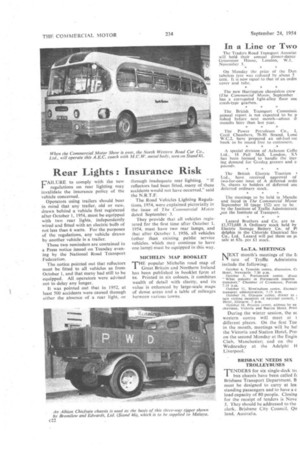Rear Lights : Insurance Risk F AILURE to comply with the
Page 88

If you've noticed an error in this article please click here to report it so we can fix it.
new regulations on rear lighting may invalidate the insurance policy of the vehicle concerned.
Operators using trailers should bear in mind that any trailer, old or new, drawn behind a vehicle first registered after October 1, 1954, must be equipped with two rear lights, independently wired and fitted with an electric bulb of not less than 6 watts. For the purposes of the regulations, any vehicle drawn by another vehicle is a trailer.
These two reminders are contained in a Press notice issued on Tuesday evening by the National Road Transport .Federation.
The notice pointed out that reflectors must be fitted to all vehicles as from October 1, and that many had still to be equipped. All operators were advised not to delay any longer.
It was pointed out that in 1952, at least 500 accidents were caused through either the absence of a rear light, or
through inadequate rear lighting. "If reflectors had been fitted, many of these accidents would not have occurred,said the N.R.T.F, • The Road Vehicles Lighting Regulations, 1954, were explained pictorially in the issue of The Commercial Motor dated September 3.
They provide that all vehicles registered for the first time after October 1, 1954, must have two rear lamps, and that after October I. 1956, all vehicles (other than existing public service vehicles, which may continue to have one lamp) must be equipped in this way.
MICHELIN MAP BOOKLET
THE popular Michelin road map of Great Britain and Northern Ireland has been published in booklet form at 6s. Printed in six colours, it combines wealth of detail with clarity, and its value is enhanced by large-scale maps of dense areas and a table of mileages between various towns.
























































































































































































































































































































